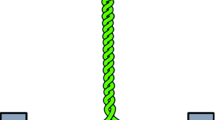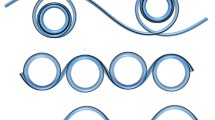Abstract
Helices made of polymeric elastic filaments have been the target of considerable and growing interest in past years, given several potential applications. Although the underlying mechanisms responsible for the formation of such helices are still not sufficiently understood, recent results suggest they may result from buckling instabilities emerging from torsion in the extremities or when there is asymmetry across the filament’s cross section. Also, the occurrence of perversions (regions where the helical handedness changes) has attracted considerable interest in a number of theoretical works, but the possibility of creating more than a single perversion, and thus control the geometry of helices and perversions in the resulting filament, has been given much less attention, despite its clear importance. In this paper, we present coarse-grained Molecular dynamics (MD) simulations that show it is possible to replicate the formation of helices and perversions within certain conditions, and which complement information available from experimental approaches. We show how the helical radius can depend on the strength and the asymmetry of the pairwise interactions, the filament’s aspect ratio, and the strain rate of recovery, and we discuss in detail how perversions occur. The bonding potential parameters were found to have a small effect on the number of perversions, while the strain rate exhibited a significant effect, namely, an increase in 200-fold of the strain rate can induce as many as eight times more perversions for an aspect ratio of 200 (and three times more perversions for an aspect ratio of 50). The increase in the pair-wise interaction stiffness leads to lower loop diameters and higher number of loops, while an increase in the pair-wise equilibrium distance leads to larger loop diameters and consequently a lower number of loops; however, both these parameters exhibit a strong dependence on the aspect ratio. It was also found that an increase in the surface modification by 30% leads to an increase in circa 2.3 times the number of formed loops, while the average loop diameter decreases by circa 40%. From these results emerges a better understanding of how to tailor the geometry of the studied polymer elastic filaments, vital information for the design of next-generation nano-mechanical systems, such as those obtained by nano-patterning of soft materials.
Graphical abstract
Different number of perversions resulting from different strain rates during deformation (strain rate of case a is 200 times that of case b)
















Similar content being viewed by others
Data availability
Data can be made available on reasonable request.
Code availability
Simulations were performed using open-source software (LAMMPS).
References
Gerbode SJ, Puzey JR, McCormick AG, Mahadevan L (2012) How the cucumber tendril coils and overwinds. Science 337:1087
Shariatpanahi SP, Iraji zad A, Abdollahzadeh I, Shirsavar R, Bonn D, Ejtehadi R, (2011) Micro helical polymeric structures produced by variable voltage direct electrospinning. Soft Matter 7:10548
Godinho MH, Canejo JP, Feio G, Terentjev EM (2010) Self-winding of helices in plant tendrils and cellulose liquid crystal fibers. Soft Matter 6:5965
Darwin C (1876) The movements and habits of climbing plants. Appleton, New York, 2nd ed.
Godinho MH, Trindade AC, Figueirinhas JL, Melo LV, Brogueira P, Deus AM, Teixeira PIC (2006) Tuneable micro- and nano-periodic structures in a free-standing flexible urethane/urea elastomer film. Eur Phys J E 21:319
Wilson DK, Kollu T (1991) The production of textured yarns by the false-twist technique. Text Prog 21:1
Almeida APC, Querciagrossa L, Silva PES, Gonçalves F, Canejo JP, Almeida PL, Godinho MH, Zannoni C (2019) Reversible water driven chirality inversion in cellulose-based helices isolated from Erodium awns. Soft Matter 15:2838
McMillen T, Goriely A (2002) Tendril perversion in intrinsically curved rods. J Nonlinear Sci 12:241
Nizette M, Goriely A (1999) Towards a classification of Euler-Kirchhoff filaments. J Math Phys 40:2830
Goriely A, Tabor M (2000) The Nonlinear Dynamics of Filaments. Nonlinear Dyn 21:101
Domokos G, Healey TJ (2005) Multiple helical perversions of finite intrinsically curved rods. Int J Bifurc Chaos 15:871
Hancock JC, Nisbet ML, Zhang W, Halasyamani PS, Poeppelmeier KR (2020) Periodic Tendril Perversion and Helices in the AMoO2F3 (A = K, Rb, NH4, Tl) Family. J Am Chem Soc 142:6375–6380
Han T, Reneker DH, Yarin AL (2007) Buckling of jets in electrospinning. Polymer 48:6064
Yu J, Qiu Y, Zha X, Yu M, Yu J, Rafique J, Yin J (2008) Production of aligned helical polymer nanofibers by electrospinning. Eur Polym J 44:2838
Xin Y, Huang ZH, Yan EY, Zhang W, Zhao Q (2006) Controlling poly(p-phenylene vinylene)/poly(vinyl pyrrolidone) composite nanofibers in different morphologies by electrospinning. Appl Phys Lett 89:053101
Shin MK, Kim SI, Kim SJ (2006) Reinforcement of polymeric nanofibers by ferritin nanoparticles. Appl Phys Lett 88:193901
Silva PES, de Abreu FV, Godinho MH (2017) Shaping helical electrospun filaments: a review. Soft Matter 13:6678
Xiuling Y, Jingwen W, Hongtao G, Li L, Wenhui X, Gaigai D (2020) Structural design toward functional materials by electrospinning A review. E-Polymers 20:682–712
Wang JS, Feng XQ, Wang GF, Yu SW (2008) Twisting of nanowires induced by anisotropic surface stresses. Appl Phys Lett 92:191901
Wang JS, Ye HM, Qin QH, Xu J, Feng XQ (2012) On the spherically symmetric Einstein–Yang–Mills–Higgs Equations in Bondi coordinates. Proc R Soc A Math Phys Eng Sci 468:609
Huang J, Liu J, Kroll B, Bertoldi K, Clarke DR (2012) Spontaneous and deterministic three-dimensional curling of pre-strained elastomeric bi-strips. Soft Matter 8:6291
Jiang H, Hou Z (2014) Motion transition of active filaments: rotation without hydrodynamic interactions. Soft Matter 10:1012
Jiang H, Hou Z (2014) Hydrodynamic interaction induced spontaneous rotation of coupled active filaments. Soft Matter 10:9248
Isele-Holder RE, Elgeti J, Gompper G (2015) Self-propelled worm-like filaments: spontaneous spiral formation, structure, and dynamics. Soft Matter 11:7181
Wisinger CE, Maynarda LA, Barone JR (2019) Bending, curling, and twisting in polymeric bilayers. Soft Matter 15:4541
Wada H (2016) Structural mechanics and helical geometry of thin elastic composites. Soft Matter 12:7386–7397
de Gennes PG (1971) Reptation of a Polymer Chain in the Presence of Fixed Obstacles. J Chem Phys 55:572
Abreu FV, Dias RG, von Ferber C (2008) Pseudo-knots in helical structures. Soft Matter 4:731
Gates TS, Hinkley JA (2003) Computational materials : modeling and simulation of nanostructured materials and systems. National Aeronautics and Space Administration, Langley Research Center, Hampton, VA.
Hossain D, Tschopp MA, Ward DK, Bouvard JL, Wang P, Horstemeyer MF (2010) Molecular dynamics simulations of deformation mechanisms of amorphous polyethylene. Polymer 51:6071
Tschopp MA, Bouvard JL, Ward DK, Horstemeyer MF (2011) Supplemental Proceedings, Vol 2: Materials Fabrication, Properties, Characterization and Modeling. John Wiley & Sons, 789–794.
Ge T, Robbins MO (2010) Anisotropic plasticity and chain orientation in polymer glasses. J Polym Sci Part B Polym Phys 48:1473
Hoy RS (2011) Why is understanding glassy polymer mechanics so difficult. J Polym Sci Part B Polym Phys 49:979
Hoy RS, Robbins MO (2006) Strain hardening of polymer glasses: Effect of entanglement density, temperature, and rate. J Polym Sci Part B Polym Phys 44:3487
Simoes R, Cunha AM, Brostow W (2006) Molecular Dynamics Simulations 0f Polymer Viscoelasticity: Effect of the Loading Conditions and Creep Behavior. Model Simul Mater Sci Eng 14:157
Simoes R, Cunha AM, Brostow W (2006) Computer Simulations of True Stress Development and Viscoelastic Behavior in Amorphous Polymeric Materials. Comput Mater Sci 36:319
Brostow W, Khoja S, Simoes R (2017) Sliding wear behavior of polymers studied with mesoscopic molecular dynamics. J Mater Sci 52:1203
Capaldi FM, Boyce MC, Rutledge GC (2002) Enhanced Mobility Accompanies the Active Deformation of a Glassy Amorphous Polymer. Phys Rev Lett 89:175505
Capaldi FM, Boyce MC, Rutledge GC (2004) Molecular response of a glassy polymer to active deformation. Polymer 45:1391
Hoy RS, O’Hern CS (2010) Viscoplasticity and large-scale chain relaxation in glassy-polymeric strain hardening. Phys Rev E 82:041803
Rudd RE, Broughton JQ (2000) Concurrent Coupling of Length Scales in Solid State Systems. Phys Status Solidi 217:251
Frederix K (2010) Structured Matrices and Their Applications. PhD thesis, Faculty of Engineering Science, KU Leuven.
Plimpton S (1995) Fast Parallel Algorithms for Short-Range Molecular Dynamics. J Comput Phys 117:1
Humphrey W, Dalke A, Schulten K (1996) VMD: Visual molecular dynamics. J Mol Graph 14:33
Peter C, Kremer K (2009) Soft Matter, Fundamentals and Coarse Graining Strategies. In: Multiscale Simulation Methods in Molecular Sciences, eds Grotendorst, J, Attig, N, Blügel, S Marx, and D, Forschungszentrum Jülich, vol 42, pp 337.
Grest GS, Kremer K (1986) Molecular dynamics simulation for polymers in the presence of a heat bath. Phys Rev A 33:3628
Kremer K, Grest GS (1990) Dynamics of entangled linear polymer melts: A molecular-dynamics simulation. J Chem Phys 92:5057
Auhl R, Everaers R, Grest GS, Kremer K, Plimpton SJ (2003) Equilibration of long chain polymer melts in computer simulations. J Chem Phys 119:12718
Iwamoto S, Lee SH, Endo T (2014) Relationship between aspect ratio and suspension viscosity of wood cellulose nanofibers. Polym J 46:73
Amiralian N, Annamalai PK, Garvey CJ, Jiang W, Memmott P, Martin DJ (2017) High aspect ratio nanocellulose from an extremophile spinifex grass by controlled acid hydrolysis. Cellulose 24:3753
Silva P, Trigueiros J, Trindade A, Simoes R, Dias RG, Godinho MH, de Abreu FV (2016) Perversions with a twist Sci Rep 6:23413
Izrailev S, Stepaniants S, Isralewitz B, Kosztin D, Lu H, Molnar F, Wriggers W, Schulten K (1999) Steered Molecular Dynamics. In: Computational Molecular Dynamics: Challenges, Methods, Ideas SE - 2, eds Deuflhard P, Hermans J, Leimkuhler B, Mark A, Reich S, Skeel R, Springer, Berlin Heidelberg, vol 4, pp 39.
Lazarus A, Miller JT, Metlitza MM, Reis PM (2013) Contorting a heavy and naturally curved elastic rod. Soft Matter 9:8274
Gruziel M, Szymczak P (2015) From ribbons to tubules: a computational study of the polymorphism in aggregation of helical filaments. Soft Matter 11:6294
Silva P, Godinho MH (2017) Helical Microfilaments with Alternating Imprinted Intrinsic Curvatures. Macromol Rapid Commun 38:1600700
Acknowledgements
This work is funded by FEDER funds through the COMPETE 2020 program and National Funds through the Portuguese Foundation for Science and Technology (FCT) to IPC under projects UIDB/05256/2020 and UIDP/05256/2020.
Author information
Authors and Affiliations
Corresponding author
Ethics declarations
Conflicts of interest
The authors have no conflicts of interest to declare that are relevant to the content of this article.
Additional information
Publisher's Note
Springer Nature remains neutral with regard to jurisdictional claims in published maps and institutional affiliations.
Rights and permissions
About this article
Cite this article
Lopes, J.P.T., Vistulo de Abreu, F. & Simoes, R. Modeling the mechanisms for formation of helices and perversions in elastic nanofilaments through molecular dynamics. Polym. Bull. 79, 1929–1947 (2022). https://doi.org/10.1007/s00289-021-04013-0
Received:
Revised:
Accepted:
Published:
Issue Date:
DOI: https://doi.org/10.1007/s00289-021-04013-0




